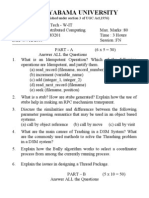B Trees
B Trees
Uploaded by
thskumar0 ratings0% found this document useful (0 votes)
286 views6 pagesA B-tree is a tree data structure that keeps data sorted and allows efficient searches, insertions and deletions. It is commonly used in databases and file systems. B-trees allow for faster searches than binary search trees by having nodes with more than two children, reducing the number of required disk accesses. B-trees are optimized for systems that read and write large blocks of data from disk.
Original Description:
B Trees
Copyright
© © All Rights Reserved
Available Formats
DOCX, PDF, TXT or read online from Scribd
Share this document
Did you find this document useful?
Is this content inappropriate?
Report this DocumentA B-tree is a tree data structure that keeps data sorted and allows efficient searches, insertions and deletions. It is commonly used in databases and file systems. B-trees allow for faster searches than binary search trees by having nodes with more than two children, reducing the number of required disk accesses. B-trees are optimized for systems that read and write large blocks of data from disk.
Copyright:
© All Rights Reserved
Available Formats
Download as DOCX, PDF, TXT or read online from Scribd
Download as docx, pdf, or txt
0 ratings0% found this document useful (0 votes)
286 views6 pagesB Trees
B Trees
Uploaded by
thskumarA B-tree is a tree data structure that keeps data sorted and allows efficient searches, insertions and deletions. It is commonly used in databases and file systems. B-trees allow for faster searches than binary search trees by having nodes with more than two children, reducing the number of required disk accesses. B-trees are optimized for systems that read and write large blocks of data from disk.
Copyright:
© All Rights Reserved
Available Formats
Download as DOCX, PDF, TXT or read online from Scribd
Download as docx, pdf, or txt
You are on page 1of 6
B-tree
In computer science, a B-tree is a tree data structure that keeps data
sorted and allows searches, sequential access, insertions, and deletions
in logarithmic time. The B-tree is a generalization of a binary search
tree in that a node can have more than two children (Comer 1979,
p. 123). Unlike self-balancing binary search trees, the B-tree is
optimized for systems that read and write large blocks of data. It is
commonly used in databases and file systems.
Invented by (1972):
Rudolf Bayer, Edward M.
McCreight
Time complexity in big O notation
Average Worst case
Space O(n) O(n)
Search O(log n) O(log n)
Insert O(log n) O(log n)
Delete O(log n) O(log n)
Problem: Data base too big to fit memory Disk reads are slow
Example: 1,000,000 records on disk Binary search might take 20 disk reads. Disk reads are done in blocks
Suppose one block read can retrieve 100 records,
General Definition:
A B-Tree of order m is an m-way tree such that
1. All leaf nodes are at the same level.
2. All non-leaf nodes (except the root) have at most m and at least m/2 children.
3. The number of keys is one less than the number of children for non-leaf nodes and at most m-1 and
at least m/2 for leaf nodes.
4. The root may have as few as 2 children unless the tree is the root alone.
Example for m=5
Definition:
A B-Tree of order 5 is an 5-way tree such that
1. All leaf nodes are at the same level.
2. All non-leaf nodes (except the root) have at most 5 and at least 2 children.
3. The number of keys is one less than the number of children for non-leaf nodes and at most 4 and at
least 2 for leaf nodes.
4. The root may have as few as 2 children unless the tree is the root alone.
A B-tree is a method of placing and locating files (called records or keys) in a database. (The meaning of
the letter B has not been explicitly defined.) The B-tree algorithmminimizes the number of times a
medium must be accessed to locate a desired record, thereby speeding up the process.
B-trees are preferred when decision points, called nodes, are on hard disk rather than in random-access
memory (RAM). It takes thousands of times longer to access a data element from hard disk as compared
with accessing it from RAM, because a disk drive has mechanical parts, which read and write data far
more slowly than purely electronic media. B-trees save time by using nodes with many branches (called
children), compared with binary trees, in which each node has only two children. When there are many
children per node, a record can be found by passing through fewer nodes than if there are two children per
node. A simplified example of this principle is shown below.
In a tree, records are stored in locations called leaves. This name derives from the fact that records always
exist at end points; there is nothing beyond them. The maximum number of children per node is the order
of the tree. The number of required disk accesses is the depth. The image at left shows a binary tree for
locating a particular record in a set of eight leaves. The image at right shows a B-tree of order three for
locating a particular record in a set of eight leaves (the ninth leaf is unoccupied, and is called a null). The
binary tree at left has a depth of four; the B-tree at right has a depth of three. Clearly, the B-tree allows a
desired record to be located faster, assuming all other system parameters are identical. The tradeoff is that
the decision process at each node is more complicated in a B-tree as compared with a binary tree. A
sophisticated program is required to execute the operations in a B-tree. But this program is stored in
RAM, so it runs fast.
struct BTreeNode
{
int *keys; // An array of keys
int t; // Minimum degree
BTreeNode *C; // An array of child pointers
int n; // Current number of keys
int leaf; // Is 1 when node is leaf. Otherwise 0
};
Example: Creating a B-tree of order 5
A G F B K D H M J E S I R X C L N T U P
1. [Result of inserting A G F B K ]
2.
3. [insert D H M]
4. [insert J]
5.
6. [ insert E S I R]
7. [insert X]
8. [insert C]
9.
10. [insert L N T U]
11. [insert P]
12.
13.
Deleting Nodes
Delete E from leaf node
[Delete E]
[borrowing from the neighbour]
[delete F, Cant borrow]
[so combine]
[Delete M]
[Borrowing from the neighbour]
Create a B-tree of order 5, when the keys arrive in the following order:
A F G B K D M J E S I X R Y => 1 6 7 2 11 4 13 10 5 19 9 24 18 25
Thus the final tree is:
[animation in java applet: http://slady.net/java/bt/view.php?w=600&h=450]
Create a B-tree of order 3, when the keys arrive in the following order:
10 24 23 11 31 16 26 35 29 20 46 28
You might also like
- Group DiscDocument38 pagesGroup Discmollelbaraka38No ratings yet
- Data Structures, Algorithms, and Software Principles in CDocument778 pagesData Structures, Algorithms, and Software Principles in CNikhilGoyal100% (3)
- Dbms Unit 5.2 (Ar16)Document23 pagesDbms Unit 5.2 (Ar16)X BoyNo ratings yet
- B. DBMS (Answer) : I. Multi ChoiceDocument2 pagesB. DBMS (Answer) : I. Multi ChoiceTolaNo ratings yet
- Client Server Architecture A Complete Guide - 2020 EditionFrom EverandClient Server Architecture A Complete Guide - 2020 EditionNo ratings yet
- Pollock 2005 SPSS I 1 3Document68 pagesPollock 2005 SPSS I 1 3Alehandra Uifalean100% (1)
- Introduction To ERPNext PDFDocument34 pagesIntroduction To ERPNext PDFPuji Napitupulu67% (3)
- Login Form in AccessDocument6 pagesLogin Form in AccessKhrstn BotinNo ratings yet
- B Tree ApplicationDocument6 pagesB Tree Applicationsudhialamanda100% (2)
- B-Trees: Balanced Tree Data StructuresDocument10 pagesB-Trees: Balanced Tree Data Structuresarun10y07No ratings yet
- UNIT 5 File Organization in DBMSDocument22 pagesUNIT 5 File Organization in DBMSprasadNo ratings yet
- Data Structure Preliminaries, Array and Linked ListDocument9 pagesData Structure Preliminaries, Array and Linked ListAntonio RogersNo ratings yet
- Database Management Short NotesDocument5 pagesDatabase Management Short NotesSamsung TVNo ratings yet
- Linear Arrays Representation & Traversal Insertion Deletion Linear Search Bubble Sort Binary SearchDocument18 pagesLinear Arrays Representation & Traversal Insertion Deletion Linear Search Bubble Sort Binary SearchAnanth KallamNo ratings yet
- CS301 Finalterm Subjective 2013 Solved - 2Document16 pagesCS301 Finalterm Subjective 2013 Solved - 2Network Bull100% (2)
- CST3504 Test 1 - 60 Practice Questions For CH 1 and 6Document9 pagesCST3504 Test 1 - 60 Practice Questions For CH 1 and 6Randy Naraine100% (1)
- Software Engineering Tools and PracticesDocument37 pagesSoftware Engineering Tools and PracticesNasis DerejeNo ratings yet
- BIGDATA LAB MANUALDocument27 pagesBIGDATA LAB MANUALjohn wickNo ratings yet
- AIML Module 3Document25 pagesAIML Module 3sriharshapatilsbNo ratings yet
- Heap AlgorithmDocument6 pagesHeap AlgorithmMaysam AlkeramNo ratings yet
- Data NormalisationDocument10 pagesData Normalisationkomal komalNo ratings yet
- B Tree: Max Keys m-1 Min Keys (m/2) - 1 Max Child M Min Children m/2Document8 pagesB Tree: Max Keys m-1 Min Keys (m/2) - 1 Max Child M Min Children m/2prut.joshNo ratings yet
- Database RevisionDocument10 pagesDatabase RevisionSergio YazNo ratings yet
- Unix OsDocument23 pagesUnix OsParvathi Goud100% (1)
- ccs341 Data Warehousing Lab Manual2021Document41 pagesccs341 Data Warehousing Lab Manual2021BhuvaneshNo ratings yet
- 18CS53 - Database Management SystemDocument52 pages18CS53 - Database Management SystemYASHASHWINI SNo ratings yet
- Lesson10 - FAT - FILE SYSTEMDocument39 pagesLesson10 - FAT - FILE SYSTEMdelanzoe100% (1)
- 18CS42 Model Question Paper - 1 With Effect From 2019-20 (CBCS Scheme)Document3 pages18CS42 Model Question Paper - 1 With Effect From 2019-20 (CBCS Scheme)M.A rajaNo ratings yet
- HNDIT1211 Data Structures and AlgorithmsDocument4 pagesHNDIT1211 Data Structures and AlgorithmsJaroos MohamedNo ratings yet
- DMW Question PaperDocument7 pagesDMW Question PaperJean Claude0% (1)
- DBMS Components Questions and Answers - SanfoundryDocument6 pagesDBMS Components Questions and Answers - Sanfoundryabdul rehmanNo ratings yet
- Chapter 8: Main Memory: Silberschatz, Galvin and Gagne ©2013 Operating System Concepts - 9 EditionDocument54 pagesChapter 8: Main Memory: Silberschatz, Galvin and Gagne ©2013 Operating System Concepts - 9 EditionnitishaNo ratings yet
- DBMS Unit 3Document98 pagesDBMS Unit 3Varun GuptaNo ratings yet
- Merge SortDocument15 pagesMerge Sortapi-3825559No ratings yet
- DSBDa MCQDocument17 pagesDSBDa MCQnoxexNo ratings yet
- CS8091 Bigdata Analytics Lessonplan With DateDocument11 pagesCS8091 Bigdata Analytics Lessonplan With DateitnbaNo ratings yet
- DBMS Question Bank SOCET CE DepartmentDocument6 pagesDBMS Question Bank SOCET CE DepartmentSingh BhiNo ratings yet
- BDC Previous Papers 2 MarksDocument7 pagesBDC Previous Papers 2 MarksRoshan Mallipeddi100% (1)
- Final PPT TreesDocument18 pagesFinal PPT Treesmarv hartiganNo ratings yet
- DAA Branch and BoundDocument32 pagesDAA Branch and BoundChaitanyaNo ratings yet
- DOS CommandsDocument19 pagesDOS CommandsDharmendra Koguru100% (1)
- Software Configuration Management (SCM)Document9 pagesSoftware Configuration Management (SCM)Sagar SaikiaNo ratings yet
- Os Lab - Terminal Exam - Spring 2021Document4 pagesOs Lab - Terminal Exam - Spring 2021Maaz Chauhann100% (1)
- sathyabama-IIsem-Distributed Computing-683201-783201Document2 pagessathyabama-IIsem-Distributed Computing-683201-783201ShankarNo ratings yet
- Chapter - 11: Access Layer: Object Storage and Object InteroperabilityDocument8 pagesChapter - 11: Access Layer: Object Storage and Object Interoperabilitydeeparanjini100% (1)
- Intro To UNIXDocument67 pagesIntro To UNIXArjunSahooNo ratings yet
- Oltp VS OlapDocument9 pagesOltp VS OlapSikkandar Sha100% (1)
- DBMS Full NotesDocument99 pagesDBMS Full NotesMD ASHRAFNo ratings yet
- Module 1 DSADocument16 pagesModule 1 DSApradeepnagaral5No ratings yet
- DBMS MCQ BankDocument96 pagesDBMS MCQ BankRamkishan ShindeNo ratings yet
- Network Layer Imp QuestionsDocument1 pageNetwork Layer Imp QuestionsCSE 14 Maria NaveenNo ratings yet
- Cb3401-Unit 1Document28 pagesCb3401-Unit 1Reshma Radhakrishnan100% (1)
- File Hanling - New - C++Document26 pagesFile Hanling - New - C++Shubham agrayNo ratings yet
- Data Structure Using C: Proposal On Phone Directory Application Using Doubly-Linked ListDocument5 pagesData Structure Using C: Proposal On Phone Directory Application Using Doubly-Linked Listgirish desaiNo ratings yet
- CS8492 /database Management Systems 2017 Regulations: Unit Iv Implementation TechniquesDocument22 pagesCS8492 /database Management Systems 2017 Regulations: Unit Iv Implementation TechniquesHarshath MNo ratings yet
- Model Question PaperDocument2 pagesModel Question PaperLuke KennyNo ratings yet
- Dbms PracticalDocument2 pagesDbms Practicalnagarajuvcc1230% (1)
- Assignment 1 OS Sem I 16 17Document1 pageAssignment 1 OS Sem I 16 17Hazimah SairinNo ratings yet
- Data Structure Questions and Answers - Singly Linked List Operations - 1Document31 pagesData Structure Questions and Answers - Singly Linked List Operations - 1M Naveed ShakirNo ratings yet
- Dbms Question PaperDocument4 pagesDbms Question PaperSasi PlacementsNo ratings yet
- Oracle Architecture ComponentsDocument43 pagesOracle Architecture ComponentsZeno Jegam100% (1)
- Driving Forces Behind Client/server: Business Perspective: Need ForDocument27 pagesDriving Forces Behind Client/server: Business Perspective: Need ForDeepak Dhiman0% (1)
- Threaded Binary TreesDocument3 pagesThreaded Binary TreesPrakash ReddyNo ratings yet
- Okonkwo Blessing Updated CVDocument2 pagesOkonkwo Blessing Updated CVFredviewNo ratings yet
- PPD PRACT-1 To 15Document70 pagesPPD PRACT-1 To 15suthar chirag0% (4)
- Erp Used in Textile IndustryDocument13 pagesErp Used in Textile Industryyo_anure0% (1)
- OA Framework Basics: 3 April, 2009 Parag Narkhede, Blink Consulting PVT LTDDocument24 pagesOA Framework Basics: 3 April, 2009 Parag Narkhede, Blink Consulting PVT LTDguptaarvind10No ratings yet
- Project Planning FormatDocument2 pagesProject Planning Formatakshita guptaNo ratings yet
- Spartan 14 ManualDocument570 pagesSpartan 14 ManualDavor ŠestanNo ratings yet
- Tutorials-EEEE 4117 Wireless and Mobile Communications SystemsDocument4 pagesTutorials-EEEE 4117 Wireless and Mobile Communications Systemsmarshal galilee djitsaNo ratings yet
- Analisis Perilaku Konsumen Terhadap Keputusan Pembelian Buah-Buahan Di Moena Fresh BaliDocument12 pagesAnalisis Perilaku Konsumen Terhadap Keputusan Pembelian Buah-Buahan Di Moena Fresh BaliridhoNo ratings yet
- Grade 6 Integers in PDFDocument3 pagesGrade 6 Integers in PDFSCEKAPS12 NPCIL100% (1)
- Social Networking ApplicationDocument28 pagesSocial Networking Applicationrarunraj008No ratings yet
- Btech JNTU CSE-2-1-DSDocument2 pagesBtech JNTU CSE-2-1-DSvijaykumar015No ratings yet
- Internet and Computing Fundamentals 8Document2 pagesInternet and Computing Fundamentals 8Sonia Agustin100% (1)
- FIN-RF-xx, External Providers Performance Evaluation FormDocument9 pagesFIN-RF-xx, External Providers Performance Evaluation Formfccts38No ratings yet
- 02.teach Yourself TagalogDocument185 pages02.teach Yourself TagalogAleishea Yamaoka100% (2)
- Syllabus of Bio-Informatics, PUCCDocument14 pagesSyllabus of Bio-Informatics, PUCCMd MohiuddinNo ratings yet
- Office 365 Licensing PricingDocument22 pagesOffice 365 Licensing PricingmdaprasannaNo ratings yet
- Honeywell Spare Parts SupplierDocument16 pagesHoneywell Spare Parts SupplierAmsindiaNo ratings yet
- Yamaha Yas-475 DiagramsDocument13 pagesYamaha Yas-475 DiagramsBetuko SaxNo ratings yet
- CCP151 Studio 5000 Logix Designer Level 2 Basic Ladder Logic ProgrammingDocument2 pagesCCP151 Studio 5000 Logix Designer Level 2 Basic Ladder Logic ProgrammingJonathan Otto100% (1)
- Ricoh Aficio-2015-2018Document6 pagesRicoh Aficio-2015-2018aortic_kfNo ratings yet
- En - Quick Start Guide - Adjust Refraction IndexDocument12 pagesEn - Quick Start Guide - Adjust Refraction IndexCero CincoNo ratings yet
- B.Tech Project Mid Term Report: Handwritten Digits Recognition Using Neural NetworksDocument13 pagesB.Tech Project Mid Term Report: Handwritten Digits Recognition Using Neural NetworksVandhana RathodNo ratings yet
- Boolean AlgebraDocument6 pagesBoolean AlgebraCristal Ann MilarpisNo ratings yet
- OverviewDocument60 pagesOverviewzoravarsNo ratings yet
- #Include #Include #Include #Include #Include Void Void Void Int Void Int Int Int Int Float Char Float Int Void Float IntDocument14 pages#Include #Include #Include #Include #Include Void Void Void Int Void Int Int Int Int Float Char Float Int Void Float Intyongjin95No ratings yet
- TR 146 PDFDocument46 pagesTR 146 PDFSai Kyaw HtikeNo ratings yet

























































































